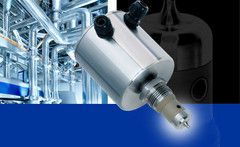
Contact Details:
Baumer Limited
33/36 Shrivenham Hundred Business Park
Watchfield
Swindon
Wiltshire
SN6 8TZ
United Kingdom
Tel: +44 (0)1793 783839
Fax: +44 (0)1793 783814
Send Enquiry | Company Information

Multi-Purpose Inductive Conductivity Transmitter
Product News Monday, October 18, 2010: Baumer Limited
- Very short response time (< 3 s)
- Extended temperature range from -20 to 130 °C
- Measuring range from 0 to 999 mS/cm covers every possible application in the food and beverage industries
- One ISL can be used in several applications thanks to hygienic G1'' process connection
With the ISL 05x, Baumer offers a sensor for inductive conductivity measurement with integrated media temperature compensation and very short response time (< 3 s).
With its 3A approval, the ISL is suitable for a variety of applications in the food and beverage industries, but also in the field of CIP (cleaning in place) of a wide range of facilities. With its measuring range from 0…999 mS/cm, the ISL covers every possible application in the food and beverage industries.
Compact and completely made from corrosion-resistant stainless steel and PEEK, the sensor can be installed in direct contact with the medium in tubes from DN40 upwards. Its very short response time of < 3 s allows for very precise measurements. With its hygienic G1" process connection, one single ISL can be used in several applications, which helps to reduce procurement costs. The ISL has an integrated LCD display for both conductivity (mS/cm) and temperature (°C) and can be configured directly, without a computer, using the ISL's one-knob navigation. These features support immediate on-site control, which is an advantage in manually controlled cleaning processes. Thanks to its extended temperature range from -20…130 °C, the ISL can also be used in SIP (sterilisation in place) facilities. The ISL has a 4…20 mA signal output for conductivity and a 4…20 mA signal output for temperature.
In the food and beverage industries, measuring the conductivity of liquids is used, among other things, to control the concentration of salt during the production of cheese, or for separating a medium from water when cleaning production facilities. Inductive conductivity measurement is based on the principle of a transformer. The liquid flowing through an opening in the sensor head forms the core of the transformer. An alternating voltage is fed into the primary coil on one side of the opening. The voltage induced by the secondary coil is measured on the other side of the opening. As the conductivity of a medium depends on its temperature, reliable results need to take the medium's temperature into account. The ISL does compensate for this temperature influence automatically.
